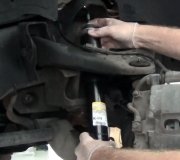Why do you say it is not the tires? Worn bushings rarely cause wobbles. Instead, the place to start is by jacking up one corner of the car so one tire is off the ground, then watch the tire tread and wheel lip as they rotate. You can spin rear wheels by hand. Some broken tire belts are real easy to spot, but some can not be seen unless you know exactly what to look for.
If the belts seem to be okay, the next step is measuring "lateral run out" with a dial indicator. Harbor Freight Tools has an inexpensive dial indicator. Place the probe on the lip of the wheel when that one is jacked up off the ground. If necessary, remove the wheel weights so they don't catch on the probe. Spin the wheel slowly, by hand, and read the amount of run out on the gauge. It typically takes at least around 0.035" run out before you will feel it.
If you find excessive run out, a bent wheel is the first suspect. Remove the wheel, then measure the run out on the hub. If that has little or no run out, check for impacted corrosion stuck between the center of the wheel and the hub. This is especially common on cars with cast wheels.
If you have rear disc brakes, the lug nuts must be installed to hold the brake rotor tight, then measure run out on the rotor's contact area the center of the wheel mounts to. That's just outside the wheel studs. If you find even a little run out there, the best suspect is some debris is stuck between the back side of the rotor and the hub.
The better suspect is still a broken tire belt. One of the clues is the wobble is felt more at a narrow range of speeds. The range you listed is right where the wheel has a natural tendency to bounce. The first thing to look for when spinning the tire is what appears to be a lump or tumor on one side of the tread. If you see that, be careful to not run your hand over the tread as there are usually very sharp wires sticking out. Those are part of the steel belts coming apart.
In many cases, that tumor grows so slowly that they wear down from normal driving. The tread surface can appear to be perfectly smooth. The elusive clue to the broken belt is to watch the grooves, and not the tread surface that contacts the road. I don't know why, but that type of belt problem almost always shows up on the inner edge of the tire, not the outer edge. If you see one of the grooves has a high spot as you spin the tire, suspect a broken belt. The effect of the broken belt isn't obvious until there is weight on the tire. This will also show up on a "road force" wheel balancer. All tire and alignment shops have them, as do many independent repair shops.
Saturday, April 15th, 2017 AT 7:18 PM


